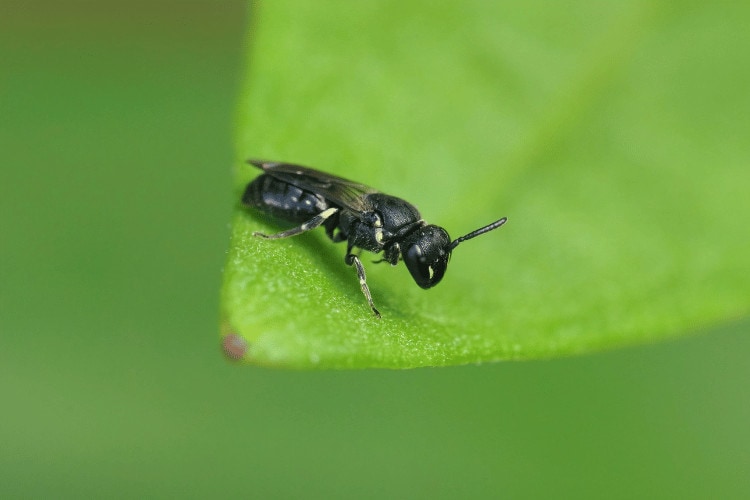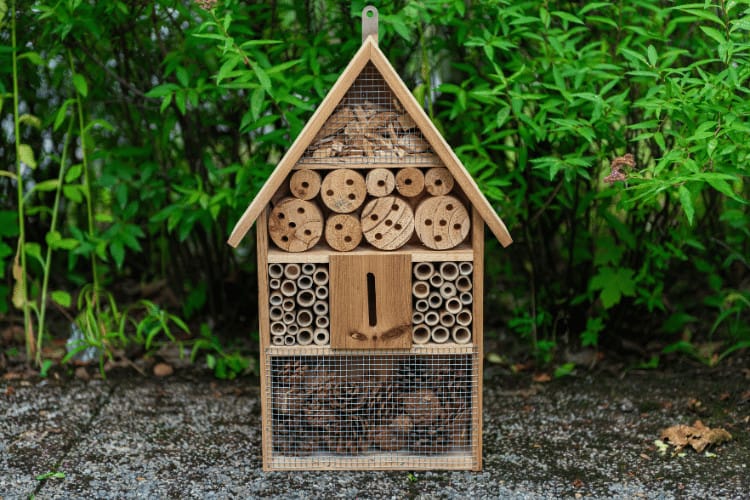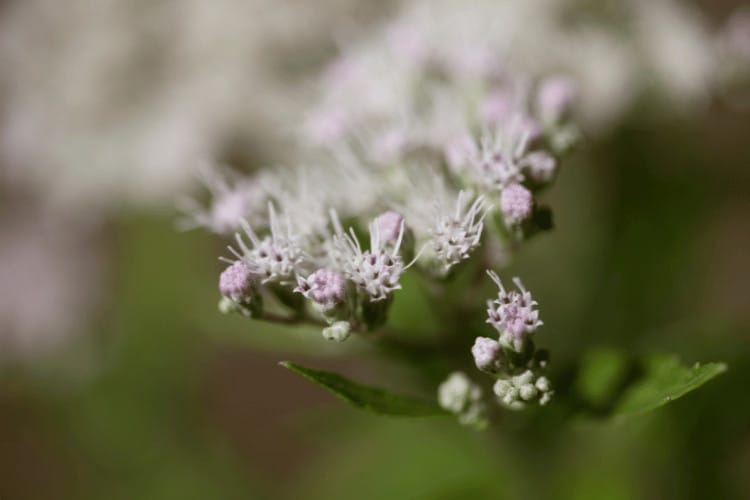The Yellow-Faced Bee: All You Need to Know Before Keeping It
As an expert beekeeper, I’ve worked with all sorts of bees, from honeybees to bumblebees to mason bees. But one of my favorites is the yellow-faced bee. These little creatures aren’t only important pollinators, but they’re also quite gentle and easy to care for.
In this article, I’ll share everything you need to know about yellow-faced bees. This includes their appearance and behavior, nesting habits, pollination benefits, and more.
So, let’s get started!
Physical Description and Personality Characteristics of Yellow-Faced Bees

Yellow-faced bees belong to the family Colletidae, which is a large family of solitary bees. The genus of yellow-faced bees is Hylaeus, and there are over 500 species in this genus.
If you’re wondering about its scientific name, it’s Hylaeus annulatus.
Now that we got all those complex terms out of the way, let’s get to know our yellow-faced friend better!
Physical Appearance
Yellow-face bees are small to medium-sized bees, ranging in length from 5 to 7 mm. They’re mostly black with yellow-white markings on their faces, legs, and thorax. The yellow markings can vary in size and shape according to the bee species.
Also, female yellow-faced bees tend to have a much smaller yellow patch of color on their faces.
Despite having slender bodies that resemble wasps, these one-of-a-kind bees are hairless. They also come with short tongues that make it a bit harder to reach into flowers for nectar, but their thin bodies make up for it, allowing them in and out smoothly!
One thing I find fascinating about yellow-faced bees is that they’re unique in their method of pollen transportation. Unlike most bees, which have pollen baskets on their hind legs, our wasp-like bees carry pollen in a special compartment on their stomachs, known as the crop.
It makes sense since their smooth bodies don’t provide a good surface for pollen to adhere to.
Character and Behavior
I’ve had the pleasure of observing yellow-faced bees in my garden, and their behavior is quite interesting to watch.
The first notable thing about yellow-faced bees is that they’re a solitary species. They don’t live in colonies like honeybees and bumblebees, so they don’t have distinct castes like queen, drone, and worker.
Each female is responsible for everything. She builds a nest, provisions it with food, and lays eggs. She does it all without any help from other bees.
The male yellow-faced bee is even more laid-back; he doesn’t have any specialized duties at all. His only role is to mate with the female bees and forage!
What Is the Purpose of Keeping Yellow-Faced Bees?
Yellow-faced bees aren’t typically kept by beekeepers, as they don’t produce honey. However, there are some benefits to keeping these bees as someone who wants to try their hands at the beekeeping world.
Pollination
Yellow-faced bees are important pollinators. They help pollinate a variety of flowers, including clover, dandelions, and mint.
This is beneficial for gardeners, ensuring their plants produce fruit.
They also do a wonderful job in pollinating different crops, making them the ideal choice if you’re considering starting a bee pollination business.
Biodiversity
Even better, yellow-faced bees are a native species to most regions across the world, so keeping them can support biodiversity.
Native bees are essential for the health of ecosystems since they help pollinate plants and control pests.
Yellow-Faced Bee Habitat and Foraging Preferences
Yellow-faced bees are found everywhere, from the forests of Europe to the deserts of Africa. They’re incredibly adaptable creatures that can live in a wide variety of habitats.
They mostly prefer to create homes in forests, where they pollinate wildflowers. These bees may also nest in hollow logs or other natural cavities in trees.
Yellow-faced bees are common in meadows, too, hovering over grasses and other flowering plants. They like to nest in the ground or hollow stems as well.
In deserts, yellow-faced bees pollinate cacti and other desert plants.
Where Can You Find Yellow-Faced Bees?
Yellow-faced bees are widespread over every continent except for Antarctica because they’re considered an invasive species:
- North America: While they’re found everywhere from Alaska to Mexico, they’re especially common in the eastern United States and Canada.
- South America: Yellow-faced bees exist in parts of South America, including Brazil, Argentina, and Peru.
- Europe: They’re especially common in the Mediterranean region.
- Asia: They’re more popular in China and Southeast Asia.
- Africa: Yellow-faced bees are found in different regions of Africa, including South Africa, Kenya, and Tanzania.
- Australia: While you might see these bees in Australia, they aren’t as common as in other parts of the world.
Yellow-faced bees are also seen on some islands in the Pacific Ocean, such as Hawaii and New Zealand. The specific regions where yellow-faced bees thrive can vary depending on the species.
For example, the Hylaeus annulatus species lives in North America, Europe, and Asia.
On the other hand, the Hylaeus akoko species is native to the island of Hawaii only, making it the rarest species of this bee family. This species is referred to as the endangered Hawaiian yellow-faced bee, and it’s been labeled as critically imperiled by the Xerces Society.
That’s because the endangered Hawaiian yellow-faced bee has been facing a decline in numbers due to its narrow range. In addition, its population in Hawaii is threatened by invasive species of ants.
Another variety that’s commonly found in Hawaii is Hylaeus (Nesoprosopis).
Yellow-Faced Bees Life Cycle, Mating, and Nesting

Hylaeus (Nesoprosopis) bees mate in the spring or summer. The males fly around and search for females. When they find a female, they’ll try to mate with her. The mating process is brief and usually takes place in the air.
Yellow-faced bees are opportunistic nesters. They’ll take advantage of any suitable cavity they can find, including:
- Hollow twigs and stems
- Holes in wood
- Bee hotels
- Crevices and holes in rocks and walls
Since yellow-faced bees have dainty mandibles, they can’t excavate their own nest holes. The female yellow-faced bee will typically choose a nesting site close to a food source, such as a flower garden.
Then, she’ll line the nest cavity with a cellophane or silk-like substance that she produces from her salivary glands. This cellophane-type material is a remarkable feat of engineering.
While you’ll see it as a simple substance, it feels incredibly strong. It allows yellow-faced bees to build durable nests that protect their young from the elements and predators.
Once the eggs have hatched, the larvae will feed on pollen and nectar that the female bee has collected. After a few weeks, the larvae will pupate, then they’ll emerge as adult bees.
Importance of Yellow-Faced Bees in Ecosystems and Agriculture
As you’re well aware by now, yellow-face bees pollinate many types of plants, including wildflowers, fruits, and vegetables. Of course, pollination is essential for the reproduction of plants and, ultimately, food.
Hylaeus (Nesoprosopis) bees are also crucial for the health of ecosystems. They help control pests and diseases, disperse seeds, and promote plant diversity.
In agriculture, yellow-faced bees can be used to pollinate a wide array of crops, including almonds, blueberries, and cranberries. They also pollinate greenhouse crops, such as tomatoes and cucumbers.
Ultimately, they’re important pollinators for Golden Alexanders (Zizia spp.), which belong to the carrot family.
Common Questions About Yellow-Faced Bees
What do yellow-faced bees eat?
Yellow-faced bees eat pollen and nectar, which are the sugary substances that flowers produce.
They’re especially drawn to the pollen and nectar of the Common Boneset (Eupatorium perfoliatum) and Swamp Milkweed (Asclepias incarnata). But again, their preferred type of flowers will vary greatly depending on the region.

Are yellow-faced bees dangerous?
Unlike their more aggressive cousins, honeybees, yellow-faced bees are solitary creatures that only sting when they feel personally threatened.
They won’t sting to defend their nest, and even if you swat at them or hold them, they’ll rarely sting you. This makes Hylaeus (Nesoprosopis) a wonderful option to start a beekeeping hobby, so take notes!
How to attract yellow-faced bees?
Start by planting their favorite flowers, such as:
- Clover
- Dandelions
- Mint
- Goldenrod
- Asters
- Coneflowers
- Sunflowers
- Echinacea
- Lavender
- Bee balm
Afterward, provide nest sites, like hollow stems, twigs, and other small cavities. You can even leave some dead wood in your garden or install a bee hotel.
You should also avoid using pesticides and create a water source by placing a birdbath or fountain in your yard.
Finally, it’s best to grow native plants, as they’re better for pollinators than non-native plants. Bees are more likely to visit flowers or plants that are grouped together in a sunny spot, so make that a priority, too!
To Conclude
Common yellow-face bees are solitary bees that aren’t as common as honeybees, but they’re still an important part of the pollination process.
If you want to attract Hylaeus (Nesoprosopis) bees to your garden, you can plant a variety of flowers that they like, such as clover, dandelions, and mint. You may also provide them with suitable nesting sites.
I know that these bees aren’t a typical choice for beekeepers, but they can still be incredibly rewarding for a beginner. They’ll do a wonderful job of introducing you to the beekeeping world due to their mild temperament and docile nature!
